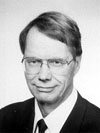Plenary Talk
Thursday August 21,
Prof. Martti Hallikainen (Helsinki Univ. of Technology, Finland)
"Microwave Radiometry for Remote Sensing of the Earth Surfaces"
*** This plenary talk is CANCELLED. ***
 Abstract.
Abstract.
This presentation will review recent developments in microwave radiometry including the introduction of interferometric radiometry in remote sensing. Microwave radiometers have been used in satellite remote sensing of the Earth since the 1960's. They measure the intensity of thermal radiation emitted by the target, expressed as brightness temperature. Multi-frequency dual-polarized radiometers contain several receivers, each operating over a certain frequency band and receiving thermal emission at either horizontal or vertical polarization. Geophysical characteristics of the target are derived from the observed brightness temperatures by employing theoretical or semi-empirical emission models. Satellite radiometers have been developed by several countries including USA, Russia, Japan and India. The main advantages of satellite microwave radiometers include their capability to provide data regardless of the lighting conditions and nearly regardless of weather conditions. The spatial resolution of real-aperture radiometers depends on frequency. The most recently launched satellite system, the AMSR-E radiometer, operates from 6.9 to 89 GHz and its antenna diameter is 1.6 m providing corresponding average spatial resolutions from 56 to 5 km. Hence, for a real-aperture radiometer operating at 1.4 GHz a very large parabolic reflector diameter would be needed in order to achieve a resolution of approximately 50 km.
The airborne ESTAR one-dimensional interferometric radiometer, developed in USA in the 1990's demonstrated that thinned antennas can be used for achieving high spatial resolution. The European Space Agency's SMOS (Soil Moisture and Ocean Salinity) satellite is scheduled for launch in 2009. The only payload is the MIRAS two-dimensional interferometric 1.4 GHz radiometer, containing tens of antenna/receiver subsystems in Y-shaped configuration. The main goals of the mission are to produce on a regular basis global maps of soil moisture and ocean surface salinity. The operation principle and technical details of the MIRAS radiometer will be discussed in the presentation. Airborne demonstrators with technical characteristics identical with those of the satellite sensor are needed in order to validate the instrument concept and provide experimental data before the launch of the SMOS satellite. This talk will present technical characteristics of the HUT-2D airborne interferometric 1.4 GHz radiometer developed by the Helsinki University of Technology. Results from recent campaigns are presented. Possible future developments in this field are discussed.
Biography.
Martti T. Hallikainen received his Doctor of Technology degree from the Helsinki University of Technology (TKK), Faculty of Electrical Engineering, in 1980. Since 1987 he is Professor of Space Technology at the Helsinki University of Technology. He was a Visiting Scientist at Jet Propulsion Laboratory and NASA Goddard Space Flight Center/University of Maryland GEST Center 2007-2008, at European Union's Joint Research Centre, Institute for Remote Sensing Applications, Italy, 1993-1994, and he was a Postdoctoral Fellow at the University of Kansas Remote Sensing Laboratory 1981-1983. His research interests include development of microwave sensors for airborne and space-borne remote sensing, development of methods to retrieve the characteristics of geophysical targets from satellite and airborne measurements, and cryospheric applications of remote sensing. He is an IEEE Fellow since 1993 and IEEE GRSS (Geoscience and Remote Sensing Society) Honorary Life Member since 2007. He was member of the GRSS Administrative Committee 1988-2006 and he served as President of IEEE GRSS 1996-1997. He was Chair of GRSS Nominations Committee 1999-2001 and 2003-2006 and he serves as GRSS Awards Committee Co-Chair since 2007. He was General Chair of the IGARSS'91 Symposium held in Espoo, Finland. He is Vice President of the International Union of Radio Science (URSI) 2005-2008 and he served as Chair of URSI Commission F 2002-2005. He is the national official member of URSI Commission F since 1988 and he was Chair of the URSI Finnish National Committee 1997-2005. He is Vice Chair of the Finnish National Committee of COSPAR since 2000.
He was member of the European Space Agency's (ESA) Earth Science Advisory Committee 1998-2001. He was Secretary General of the European Association of Remote Sensing Laboratories (EARSeL) in 1989-1993 and Chairman of the Organizing Committee for the EARSeL 1989 General Assembly and Symposium held in Espoo, Finland. He is member of EARSeL Council since 1985. He is recipient of three IEEE GRSS Awards: 1999 Distinguished Achievement Award, IGARSS'96 Interactive Paper Award and 1994 Outstanding Service Award. He was awarded the IEEE Third Millennium Medal in 2000, and the Microwave Prize for the best paper in the 1992 European Microwave Conference.
 Abstract.
Abstract.